Sedans are more practical than coupes; the people riding up front don’t have to get out in order to let people riding in the back get out.
Or get in.
But coupes look sexier than sedans.
How to split the difference?
How about a coupe on the driver’s side – and a sedan on the other side?
Plus crossover room for cargo in the backside?
The Veloster is a compact, four-seater coupe with three doors – one on the driver’s side and two on the passenger side. It solves the practicality problem that has always beset two-door, four-seater cars, which have back seats that are hard to get into – and which require the driver (or front seat passenger) to get out before anyone else can get in.
Or back out.
It also has much more room for cargo than a full-sized sedan.
It is also one of just a handful of new cars that’s still available with a manual transmission – with all three of its available engines.
You won’t find that in any currently available crossover.
Which makes the Veloster sui generis – unique.
Prices start at $18,900 – which gets you a 2.0 liter four cylinder engine without a turbo, 147 horsepower and a six speed manual transmission. Next up is the Turbo – which comes with a turbocharged 1.6 liter engine making 201 horsepower. You can choose either a six speed manual or a seven speed dual-clutch automatic transmission.
It stickers for $23,450 to start.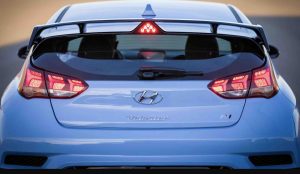
At the pinnacle is the high-performance N, which reverts to the 2.0 liter engine – pumped up to 275 horsepower via a twin-scroll turbo. You also get a limited slip differential, an Active exhaust system with baffles that open up for more performance when . . . activated. Plus an adaptive suspension system, high-performance wheel/tire package, upgraded brakes and special lightweight bolstered sport buckets plus exterior and interior trim upgrades, including a carbon fiber-trimmed rear airfoil.
The manual-equipped N lists for $32,250; with the optional automatic, the price tops out at $33,750.
All Velosters are front-wheel-drive.
The N used to be manual-only and the full 275 horsepower used to be optional – which you got when you bought the $2,100 Performance Package.
Now you have the option to select an automatic – and the full 275 horsepower is standard (250 was previously included).
Also included this year – and not available last year – is Hyundai’s SmartSense suite of driver-assistance tech, including Forward Collision Avoidance, Lane Keep Assist and Driver Attention Warning.
Also new is the Veloster N’s higher standard price.
Last year, you could get it without the extras that are now standard – and the price was $27,600.
What’s Good
Shift for yourself – or not – as you prefer.
A coupe that’s got sedan practicality for passengers – and crossover versatility for cargo.
N comes standard with more power and features than last year.
What’s Not So Good
Backseat passengers have to exit – and enter – from the passenger side.
Backseat headroom is scrunchy tight (35.9 inches).
N comes standard with a much higher MSRP than before.
Under The Hood
Hyundai has increased the drivetrain choices offered by the Veloster – which already offered more drivetrain choices than any of its rivals – of which there aren’t any, directly, since no other car offers the three-door configuration.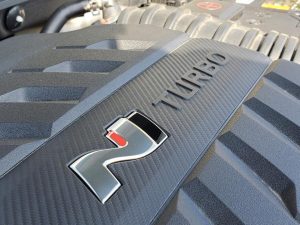
The base 2.0 liter engine makes 147 horsepower and isn’t turbocharged, which helps keep the base Veloster’s price tag well under $20k and also assures the person who buys it will never have to spend money on turbo-related repairs.
The fact that this engine relies on larger displacement to make its power rather than the power-adder of a turbocharger means it makes its power under less pressure – literally.
Turbo-boosted engines experience higher cylinder pressure (the boost) which puts more pressure on pistons, connecting rods, bearings – pretty much the whole works. It also creates more heat. All of these can be compensated for, as via heavier-duty materials and parts for the engine and heavier-duty cooling systems to cool it. But in this case it’s not necessary to compensate for them. There are fewer parts, less pressure – and for that reason lower cost for sure and probably lower repair costs later.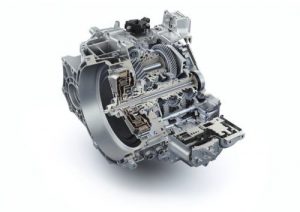
You also have the option to shift for yourself, as a six speed manual is standard.
This type of transmission is becoming generally unavailable, even in low-cost cars. If you prefer to let the transmission shift for itself, a six speed automatic is optional.
If you prefer more power, the next-up 1.6 liter turbocharged engine delivers 201 horsepower and – once again, you can shift for yourself. Or not. A six speed manual is standard and a performance-calibrated seven speed dual-clutch automatic is optional. This one includes steering wheel-mounted paddle shifters for manual control of the gear changing, at your pleasure.
The N now comes standard with a 275 horsepower version of the 2.0 liter engine, with a lot of boost (about 20 psi) and an exhaust system designed to allow exhalation to match the inhalation. This engine (and exhaust) was previously optional – and an automatic transmission was not available.
A new-design eight speed dual clutch automatic is now on the options list.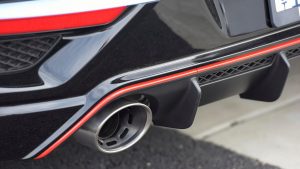
Interestingly, the automatic-equipped N’s rated gas mileage numbers (20 city, 27 highway) are slightly lower than the manual-equipped N’s numbers (22 city, 28 highway). It’s interesting because it is usually the case that an automatic-equipped version of a given car will post higher city/highway numbers – this being the chief reason for the near-ubiquity of automatics and the general disappearance of manuals.
So what’s the reason for the N’s newly available eight speed automatic, if not mileage? Probably to make the N more enticing to the Millennial demographic, which grew up in a mostly automatic world. Many people in the under 35 crowd never learned to drive a stick and for that reason, a stick-shift-only car is forbidding.
But there’s also another reason.
The N’s dual-clutch transmission is capable of very quick, very precise shifting – and that’s appealing to people who want consistent performance plus the everyday convenience of not having to shift for themselves.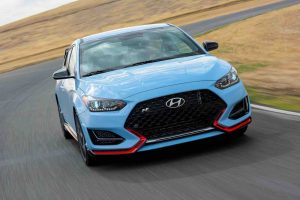
Regardless, the Veloster N is a speedy little unit, capable of getting to 60 in just over five seconds.
On The Road
The base Veloster isn’t as speedy as the Turbo or the even-more-turbo’d N – but it is more fun than other small cars because you can shift for yourself. Shifting yourself makes a car feel speedier than an automatic-only car and it also gives you more feedback and control. Automatics have their merits too, of course – including not having to shift for yourself. But it’s really nice that Hyundai offers the choice – and not just in the base trim.
The Turbo 1.6-equipped trim offers substantially more speed for not much more money. It feels even speedier because of the 195 ft.-lbs. of torque at just 1,500 RPM it makes (as opposed to the 132 ft.-lbs. at 4,500 RPM made by the base 2.0 engine, without the turbo boost). There is so much torque on hand – and so soon – that it is easy to skitter the tires from a standstill and while rolling, which is also fun.
It is even easier to skitter the tires in the N, especially now that it comes standard with 275 horsepower and 260 ft.-lbs. of torque at just 1,450 RPM – which it does because of the twin-scroll turbo used to boost its output of both horsepower and torque to levels comparable to the output of 5 liter V8s back in the ’90s.
A twin-scroll turbo is snugged close to the engine and feeds off individual exhaust ports rather than a common exhaust stream; the point being to nearly eliminate any lag time in between the time you push down on the accelerator pedal and acceleration. Normally, the build up of boost is dependent upon the build-up of exhaust gasses – to spin the turbo’s impeller wheel. But it takes a moment for exhaust gas pressure to build – and thus, for boost to build.
Enter the lag.
Also, a turbo that feeds off the general exhaust stream – all ports feeding into a common exhaust pipe – gets fluctuating gas pressure, as one port opens and another closes. The snugged-close/twin-scroll design addresses both of those issues, delivering the feel of a bigger engine rather than a boosted engine.
The N is a more hard-core thing – literally- than the Turbo 1.6 and also almost all new cars, including performance cars. Its suspension is set up for agility, razor sharp steering response, flat cornering – and a hard ride.
Well, a very firm ride.
If you like hard-core performance cars, you will like this. It is part of the experience and part of that is not endeavoring to make a performance car appealing to people who aren’t truly performance people. Who wants a gun that looks like a Desert Eagle but fires .22s?
This one won’t disappoint.
Unless you can’t quite afford it – which is the only negatory thing about this thing. Last year’s N could be had for just over $27k and that made it very price competitive with somewhat similar cars like the VW GTI, Mini Cooper S and Soobie WRX.
Two-hundred-fifty horses and a six-speed manual for that price is hard to come by.
Now it is harder to come by.
The Veloster is a tiny thing – just 166.9 inches end to end. That makes it a considerably tinier thing than a compact sedan like the Honda Civic, which is 182.7 inches end to end.
Yet both seat four.
And you don’t have to get out – if you’re the driver or the front seat passenger – to let your backseat passengers in.
Hyundai’s solution to the either-or dilemma presented by the coupe-sedan choice was to add a door to the passenger side of a car that is otherwise a coupe, especially from the driver’s side – where there is just the one door. This opens up the back seat area without anyone having to get out of their seats, up front.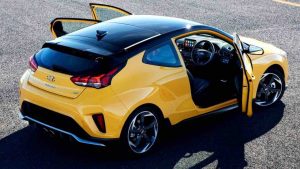
It’s not a perfect solution, though.
If you have more than one backseat passenger the other backseat passenger will have to get out to let him out (assuming the one who wants to get out is sitting behind the driver). Or let him clamber over.
And the driver will of course have to go around to the passenger side to get at whatever he tossed onto the seat behind him.
Also, there are just two backseats – not the usual (in a sedan) three – so this is a four seater three-door. And the headroom in the back is several inches less than in the front (35.9 inches vs. 38.1 inches) and you have to be careful not to bump your head getting in because of the very low roofline, which rolls downward farther than is usual, abbreviating the entry space.
That said, there is no other car this size – or with just two doors – that is as practical as the three-door Veloster.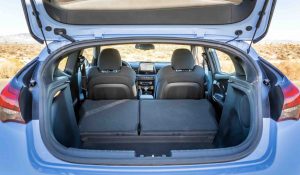
And that goes for more than just passengers.
This tiny car has 19.9 cubic feet of space for cargo behind its back seats and if you fold ’em that opens up to 44.5 cubic feet. That is easily three times as much space as you’d have available for cargo in a full-size sedan – and comparable space to what you’d get in a crossover of the same footprint. Which you can’t get with three doors – or a manual transmission.
It’s also much more space – for cargo and people – than in the BMW Mini Cooper, which is available with two or four doors. But the two door has less accessible and much less roomy back seats (just 30.8 inches of legroom back there vs. 34.1 in the Hyundai) and less than half as much space (just 8.7 cubic feet) for cargo behind its back seats. The four-door Mini has 13.1 cubic feet of cargo space behind its back seats and 32.3 inches of backseat legroom – but it’s still less than the Veloster’s got and you can’t get it without getting four doors.
Same as regards the VW GTI and other snarky, small-sized runabouts like the Soobie WRX. You can have one – or the other.
But not both in the same.
The Rest
One thing you have to have now (if you buy the N) is Hyundai’s SmartSense suite of driver assistance tech, including Forward Collision Assist, which applies the brakes if the car thinks it’s necessary to avoid a collision, Lane Keep Assist, which turns the steering wheel if the car thinks you are wandering out of your lane and Driver Attention Warning, which suggests you pay more attention if the car thinks your attention is wandering.
These “assists” are becoming as hard to avoid as a manual transmission is becoming hard to find.
They are becoming standard chiefly because there’s little cost to the manufacturer to add electronics to existing mechanical systems – many of which are already electronically controlled to one degree or another. So it’s an easy and inexpensive way for a car company to tout “new features.” And there is all kinds of pressure to appear very concerned about “safety” – though it is arguable that attentive driving is the surest way to avoid an accident and using technology to crutch the consequences of inattentive driving encourages it.
The Bottom Line
The Veloster is something no other car is – is unique. There is literally nothing else like it.
And that alone makes it very appealing.
That it is also practical, fun and – for the most part – affordable – even more so.
. . .
Got a question about cars, Libertarian politics – or anything else? Click on the “ask Eric” link and send ’em in!
If you like what you’ve found here please consider supporting EPautos.
We depend on you to keep the wheels turning!
Our donate button is here.
If you prefer not to use PayPal, our mailing address is:
EPautos
721 Hummingbird Lane SE
Copper Hill, VA 24079
PS: Get an EPautos magnet or sticker or coaster in return for a $20 or more one-time donation or a $10 or more monthly recurring donation. (Please be sure to tell us you want a magnet or sticker or coaster – and also, provide an address, so we know where to mail the thing!)
My eBook about car buying (new and used) is also available for your favorite price – free! Click here. If that fails, email me at [email protected] and I will send you a copy directly!


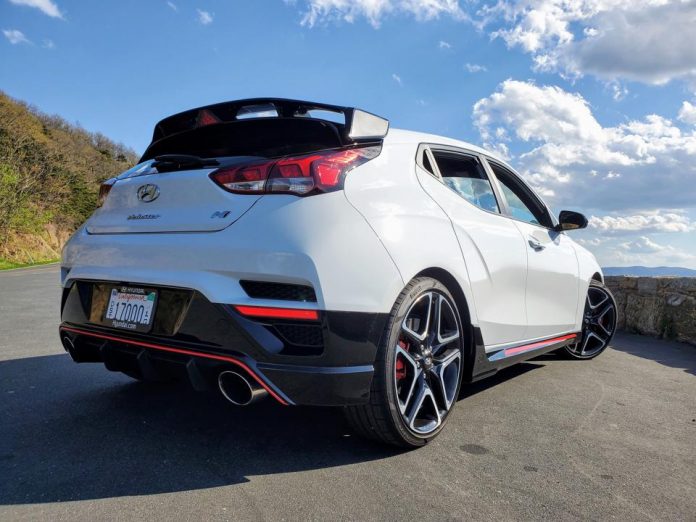

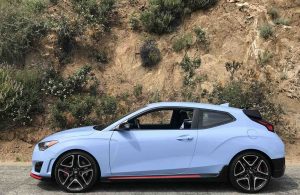
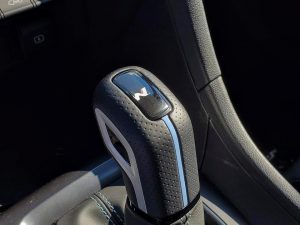
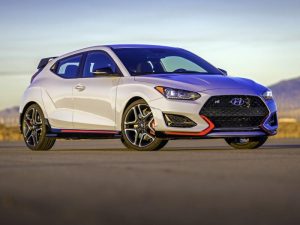







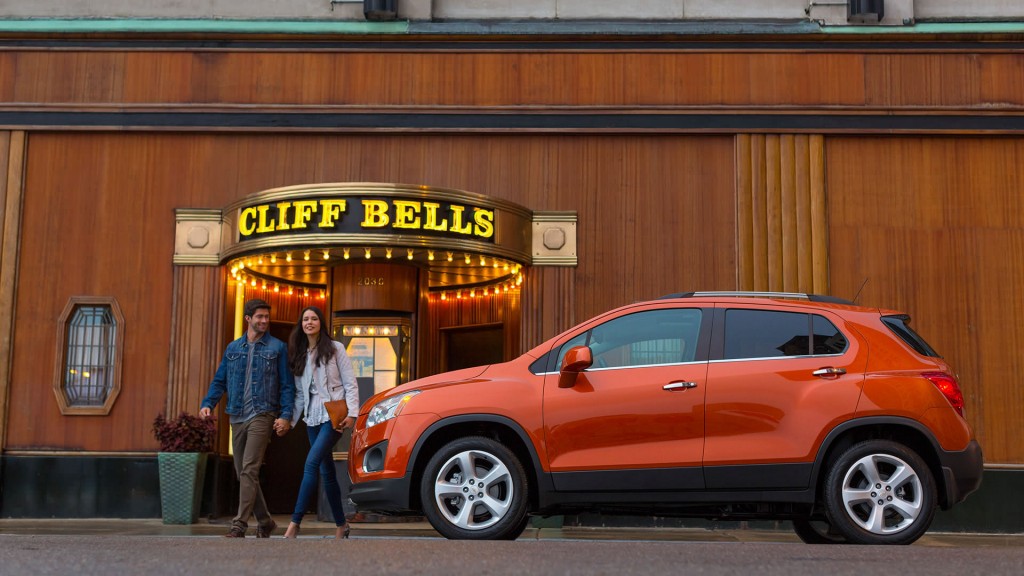
The coming Elantra N with 276hp will be quite an interesting prospect when it comes out. I’d be more into that over the Veloster. The Veloster is just odd to me.
I looked around for one of these at local dealers and the only model available was the top shelf N model. I’m not interested in paying over 30k for one; was hoping for a more economical base or 1.6 turbo with a manual.
‘The N’s dual-clutch transmission is capable of very quick, very precise shifting’ — EP
No doubt, the DCT being a servo-controlled manual transmission rather than having the torque converter of a traditional automatic.
With no clutch pedal, the DCT has to disengage one of its clutches when stopped and idling, though a few of them are fitted with an auxiliary torque converter for standing start launches.
Creeping at very slow speed (less than engine idle speed in first gear) is hard on DCTs, forcing the computer to slip the clutch.
Still prefer to work the clutch myself. But a DCT could be an acceptable halfway house for those of us who harbor a shuddering aversion to torque converters, particularly on mountain roads where DCT shift paddles give better control over engine braking.
Long term, it will be interesting to see whether DCTs can match or even exceed the reliability of torque converter automatics. The DCT’s power transmission path is all mechanical. But the servo units obviously involve hydraulics and wear, and a black box to control them.
The Hyundai is also showing quite well in the IMSA GS class with this little rocket. It’s nice to see them going racing in one of the most “stock” series you can find and being competitive to boot.
Hi Mark,
I wish I could get away with posting some videos of my … test drives….
You used to take the cars out for a spin, didn’t you?
That might be a good idea for a pay per view. lol
my wife saw one of these (previous model) this weekend and really liked it
your write up is well timed for her
You raised an interesting point about the manual transmission. I tried using the Ask Eric link earlier, but got errors, so I’ll ask my question here. Do you think it would be possible to avoid some of the nannying of new cars (specifically ASS and automatic braking) by getting a manual transmission? After all, you can’t have the car automatically stop without engaging the clutch (or automatically shifting into neutral), and it doesn’t make sense to me to shut off the car at a red light or whatever with a manual.
my understanding is ASS doesnt come with manuals for the reasons you mentioned. However good luck finding a manual at a dealer even though its technically available.
Nice job Hyundai. They have amped up this model very well. My son had a Ford Focus RS, and that thing was probably one of the top hot hatches at the time, but they don’t offer it anymore, don’t know why. I thought it was very cool, and very fun to drive. He eventually got over his infatuation with the car, probably cause I told him he would have to starting renting my pickup for his dirtbike racing, and now he drives a pickup, haha.
Hyundai is stepping up and filling the gap left without the RS. I’m sure there are others, but I don’t pay much attention to the hot hatch thing anymore.